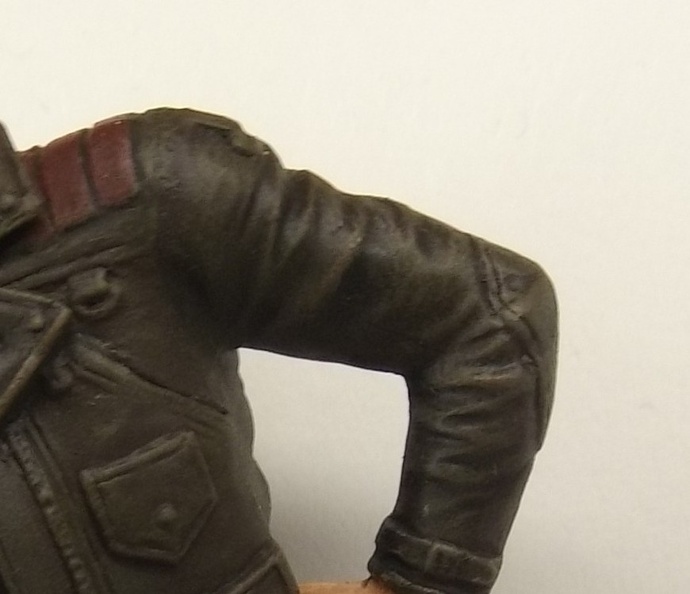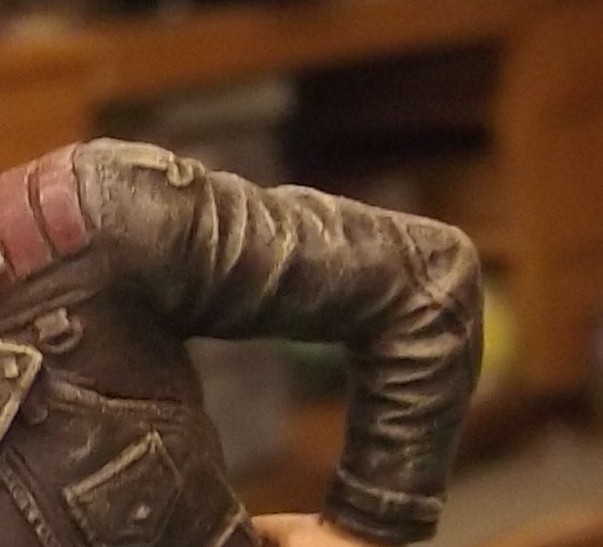Disastrous setback.
Major rookie mistake committed.
Cardinal scale modeling rule #1, PATIENCE, broken, with devastating results.
Common sense ignored.
This is very embarrassing. I can’t believe I did something so stupid. But for this build log to continue to the end, I pretty much have to own it.
@PhoenixG I read your last post rather quickly and neglected to go back and read it again a second time. What registered was “hair dryer”. What did not register was “on low heat for a few minutes”. I tried a hair dryer. I started at medium heat on medium fan. Did that for about 10 minutes. Didn’t seem to be doing anything. The wash was still tacky. Turned the hair dryer up to full blast high, full blast fan. Another 10 minutes. My bad.
Here’s the result.
I didn’t notice the distortion until ~7 hours later. Obviously, to me now, the base got very warm, if not hot. Enough to cause the distortion. It must have distorted while it cooled, I believe. I didn’t notice it right after applying the heat.
Honestly, my first reaction was that it looked kinda cool and added character. Then it soon hit me. “Wait a minute…the cell wall has to fit in the back”.
So, I did some dry fitting to see if it’s salvageable. Not going to happen. During the dry fitting I also discovered that it no longer lays flat on a table. I’ve been quite depressed since.
So, I got to wondering what contributed to this mistake in the first place? Specifically,… why was the wash still tacky after 17 hours? I attribute this to four collective possibilities.
- As mentioned, I thinned the wash with Tamiya enamel thinner, but the wash was made by AK. Perhaps the dissimilar brands do not like each other.
- I put the wash on quite heavy. This wasn’t originally intended. I just kept playing with it too much.
- Temperature. It’s generally about 18C in our basement during the day. With the heat turned down 4 degrees at night, it likely gets down to 16C or 17C overnight down there.
- It rained the night before I applied the wash. I didn’t check the humidity at the time, but it was likely higher than usual.
So, what can I learn from that wash application and do differently next time?
- Don’t slop a heavy wash on. Lay it down light. Then, after it dries, if I feel it needs more, then apply another light coat.
- Take the part upstairs after application to dry, where it’s warmer. (Talking about this with the wife…apparently she takes her earring makings upstairs, sometimes, for the clear coat to dry. Leaves them up there for a day or two. Who knew?
 )
)
Of course the main contributor to this fiasco was my impatience. I was just wanting to get the wash dried so I could proceed with a flat coat. Early to mid March, I had thought I would have this project finished by the end of March. I was hoping to get it done well before golf season (which is still two weeks away where I live) so I could shift focus on getting my 53" 1/200 Titanic hull ready, during April/May, for painting outside in the summer.
I suppose another lesson learned here is to not put a deadline or timeline on finishing a build.
All this being said, I ordered another Phantom kit last night, for replacement parts for a new base. I’m going to keep the old base as perhaps I’ll do a Phantom kitbash someday, what with all the extra parts I’m going to have.
The second kit won’t get to me for another 7-10 days, I expect. Golf season will be close to full swing by then and my Titanic build is going to take priority over this build as well.
I might get a chance to putter with the new base during the summer. We’ll see.
In the meantime, I’ll see what I can do about dry brushing of the suit.
What was intended to be completed two weeks ago, is now probably not going to be completed until the Fall. There I go implementing a timeline again.
Anyhow, sorry for the lengthy post. Thanks much for looking. Suggestions are most welcome.
Cheers,
Mark






















